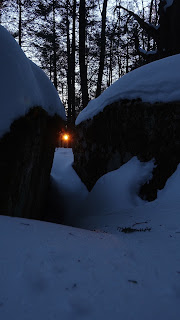"If the scientific (Anthropological,
Archaeological etc.) explanation (hypothesis) of “stone wall-like rows of stone, as fuel breaks on a fire maintained Indigenous
Ceremonial Stone Landscapes, related to Indigenous Traditional Ecological
Knowledge, is too hard to understand, then make up - and keep repeating - a deceptively simple
Eurocentric Stone Wall Myth or Fable."
"Kevin Gardner, author
of The Granite Kiss, explains how and why New England came to acquire its
thousands of miles of stone walls, the ways in which they and other dry stone
structures were built, how their styles emerged and changed over time and their
significance to the famous New England landscape. Along the way, Kevin will
occupy himself building a miniature wall on a tabletop using tiny stones.
Filmed at Windsor VT public Library" https://vimeo.com/168243938
In the Video Kevin Gardner mentions:
In Great Britain, 70,000
miles of stonewalls were built over a time period of 5,000 years.
In New England, an estimated 250,000 miles of
stone walls (a figure he thinks is too low) are assumed to have been built by
Post Contact Settler Colonists, many from Great Britain, over a time period of
200 years.
(The model Gardner creates, to his credit, reminds me of a "stone wall" I know of on the former estate of Bethlehem CT's first Puritan Minister:)
The New England Fable is that Native
American People over thousands and thousands of years made no “stone walls,”
until after 1620 (with a few exceptions, said to be rarities). The estimated
250,000 miles of stone walls, which some people contend are really stone fences
and linear trash heaps - for the most
part - assumed to be evidence of the hard (and evidently very quick) work of
European colonists and successive waves of immigrants, as a "Howling
Wilderness" was transformed into a "civilized" landscape of
European style farmsteads.
The scientific explanation is slowly
emerging from under the Fable (still clouded by a collection of Antiquarian Myths
of Lost Tribes and Ancient Worldwide Megalithic Cultures etc. - but that's
another story).
Suspects
Sherlock Stones:
"In Great Britain, 70,000 miles of
stonewalls were built over a time period of 5,000 years by many people. In New England, 250,000 miles of stone walls
were assumed to have been built by Colonists over a time period of 200 years,
more stonework than in all of the rest of the world combined, Gardner contends,"
he says. "Indigenous Peoples who lived on the same landscape since the
glaciers retreated are usually not even mentioned as possible suspects.”
Sherlock turns to me and asks:
"Who had more time to
construct an estimated quarter million miles of stone walls? Who had the more
"dire need" for all those (fire-proof) rows of stones on a Landscape
that was fire-tended and most likely pretty densely populated by 1492? Who in the long
run would have saved labor (travelling less for a more dependable and abundant
resource outcome, not burning up your firewood or all the managed resource "gardens," pruning and
maintaining just one of your blueberry fields or cranberry bogs, instead of all
of them at once)? Who is more inclined
to make petroforms or geoglyphs that resemble Great Serpents on a Sacred
Cultural Landscape?"
Stones turns to his biographer, the former Rocket Surgeon Dr. Johnnie Possum and says, "Here's a few Hypotheses to test:
If the already understudied Indigenous Cultural Landscape is ignored, particularly in the case of Ceremonial Stone Features, then wouldn’t a person be guilty of passing off Pseudoscience as Science, substituting myths for truth, and Ethnically Cleansing away evidence of thousands of years of Traditional Ecological Knowledge by claiming, without further research, that the great majority of stonework in the Northeast is the result of field clearing methods of post-contact agriculture?
If there are many free standing stone concentrations/constructions that either contain effigies or resemble animals both actual and legendary, as well as other designs and patterns that figured highly and appear in the artwork in other media created by the Indigenous People of Turtle Island (Native Americans of North America) – the turtle, bear and deer etc. along with the Great Serpents etc, - then who was more likely to have the time and motivation to create this artwork - Indigenous People or farmers fancifully and whimsically "doodling" as Thorson calls it?
If those same techniques and designs found in Indigenous artwork can be found in those longer piles of stones most often called “stone walls” then again, who was most likely to have the greater amount of time and greater motivation to create this artwork - especially when the stone wall begins with what clearly resembles a snake's head?

If the Indigenous People of Turtle Island (Native Americans of North America) maintained the landscape with fire then how were those fires controlled, especially in areas of dense population, in times of increasing territorialism? Which would be a considered the more “dire need” to justify the labor required to create nearly a quarter million miles of stone walls – fuel breaks to control Indigenous burning over a great length of time or the property boundaries and animal containment fences in the brief period of time known as the Golden Age of Stonewall Building that began shortly after the American Revolutionary War and ended with the invention of barbed wire?"
Some (Burning) Links















